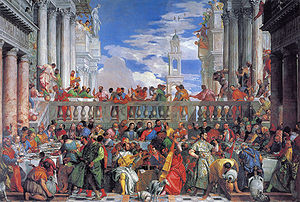- Paolo Veronese
-
Paolo Veronese 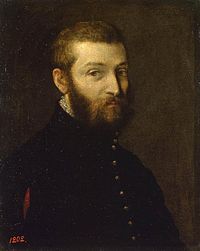
Self portraitBorn 1528 Died 1588 Nationality Italian Field Painting Movement Renaissance Paolo Veronese (1528 – April 19, 1588) was an Italian painter of the Renaissance in Venice, famous for paintings such as The Wedding at Cana and The Feast in the House of Levi. He adopted the name Paolo Cagliari or Paolo Caliari,[1] and became known as "Veronese" from his birthplace in Verona.
Veronese, Titian, and Tintoretto constitute the triumvirate of pre-eminent Venetian painters of the late Renaissance (16th century). Veronese is known as a supreme colorist, and for his illusionistic decorations in both fresco and oil. His most famous works are elaborate narrative cycles, executed in a dramatic and colorful Mannerist style, full of majestic architectural settings and glittering pageantry. His large paintings of biblical feasts executed for the refectories of monasteries in Venice and Verona are especially notable. His brief testimony with the Inquisition is often quoted for its insight into contemporary painting technique.
Contents
Life and work
Youth
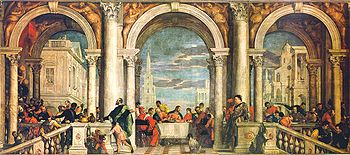 The Feast in the House of Levi (1573), one of the largest canvases of the 16th century. It led to an investigation by the Roman Catholic Inquisition.
The Feast in the House of Levi (1573), one of the largest canvases of the 16th century. It led to an investigation by the Roman Catholic Inquisition.
The census in Verona attests that Veronese was born some time in 1528 to a stonecutter named Gabriele, and his wife Catherina. By the age of fourteen Veronese apprenticed with the local master Antonio Badile, and perhaps with Giovanni Francesco Caroto. An altarpiece painted by Badile in 1543 includes striking passages that were most likely the work of his fifteen-year-old apprentice; Veronese's precocious gifts soon surpassed the level of the workshop, and by 1544 he was no longer residing with Badile.[2] Though trained in the culture of Mannerism then popular in Parma, he soon developed his own preference for a more radiant palette.[3]
Venice
He then moved briefly to Mantua in 1548 (where he created frescoes in that city's Duomo) before arriving in Venice in 1553. His first Venetian commission was a Sacra Conversazione from San Francesco della Vigna (c.1552). In 1553, he obtained his first state commission, the fresco decoration of the Sala dei Cosiglio dei Dieci (the Hall of the Council of Ten) and the adjoining Sala dei Tre Capi del Consiglio. He then painted a History of Esther in the ceiling for the church of San Sebastiano. It was his ceiling paintings for San Sebastiano, the Doge's Palace, and the Marciana Library, (the last for which Titian awarded him a prize), that established him as a master among his Venetian contemporaries.[4] Already these works indicate Veronese's mastery for referencing both the subtle foreshortening of the figures of Correggio and the heroism of those by Michelangelo.[5]
Villa Barbaro and refectory paintings
By 1556 Veronese was commissioned to paint the first of his monumental banquet scenes, the Feast in the House of Simon, which would not be concluded until 1570. However, owing to its scattered composition and lack of focus, it was not his most successful refectory mural.[6] In the late 1550s, during a break in his work for San Sebastiano, Veronese decorated the Villa Barbaro in Maser, a newly-finished building by the architect Andrea Palladio. The frescoes were designed to unite humanistic culture with Christian spirituality; wall paintings included portraits of the Barbaro family,[7] and the ceilings opened to blue skies and mythological figures. Veronese's decorations employed complex perspective and trompe l'oeil, and resulted in a luminescent and inspired visual poetry.[8] The encounter between architect and artist was a triumph.[9]
The Wedding at Cana, painted in 1562–1563, was also a collaboration with Palladio. It was commissioned by the Benedictine monks for the San Giorgio Maggiore Monastery,on a small island across from Saint Mark's, in Venice. The contract insisted on the huge size (to cover 66 square meters), and that the quality of pigment and colors should be of premium quality. For example, the contract specified that the blues should contain the precious mineral lapis-lazuli.([10]) The contract also specified that the painting should include as many figures as possible. There are three hundred portraits ( including portraits of Titian, Tintoretto, and Veronese himself) staged upon a canvas surface nearly ten metres wide. The scene, taken from the New Testament Book of John, II, 1–11, represents the first miracle performed by Jesus, the making of wine from water, at a marriage in Cana, Galilee. The foreground celebration, a frieze of figures painted in the most shimmering finery, is flanked by two sets of stairs leading back to a terrace, Roman colonnades, and a brilliant sky.[8]
In the refectory paintings, as in The Family of Darius before Alexander (1565–1570) [1], Veronese arranged the architecture to run mostly parallel to the picture plane, accentuating the processional character of the composition. The artist's decorative genius was to recognize that dramatic perspectival effects would have been tiresome in a living room or chapel, and that the narrative of the picture could best be absorbed as a colorful diversion.[11] These paintings offer little in the representation of emotion; rather, they illustrate the carefully composed movement of their subjects along a primarily horizontal axis. Most of all they are about the incandescence of light and color.[12] The exaltation of such visual effects may have been a reflection of the artist's personal well-being, for in 1565 Veronese married Elena Badile, the daughter of his first master, and by whom he would eventually have four sons and a daughter.[12]
The House of Levi
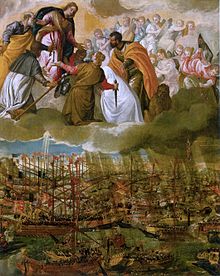 The Battle of Lepanto (c. 1572, oil on canvas, 169 × 137 cm, Gallerie dell'Accademia, Venice)
The Battle of Lepanto (c. 1572, oil on canvas, 169 × 137 cm, Gallerie dell'Accademia, Venice)
In 1573 Veronese completed the painting which is now known as the Feast in the House of Levi for the rear wall of the refectory of the Basilica di Santi Giovanni e Paolo. The painting was originally intended as a depiction of the Last Supper, designed to replace a canvas by Titian that had been lost in a fire. It measured more than five metres high and over twelve metres wide, depicted another Venetian celebration and was a culmination of his banquet scenes, which this time included not only the Last Supper, but also German soldiers, comic dwarves, and a variety of animals; in short, the exotica which were standard to his narratives.[13] Even as Veronese's use of color attained greater intensity and luminosity, his attention to narrative, human sentiment, and a more subtle and meaningful physical interplay between his figures became evident.[14]
That the subject was indeed a Last Supper, and then some, was not lost on the Inquisition. A decade earlier the monks who commissioned the Wedding at Cana had requested that the artist squeeze the maximum number of figures into the painting, but the Counter-Reformation had since exerted its influence in Venice, and in July of 1573 Veronese was summoned to explain the inclusion of extraneous and indecorous details in the painting.[15]
The tone of the hearing itself was cautionary rather than punitive; Veronese explained that "we painters take the same liberties as poets and madmen", and rather than repaint the picture, he simply and pragmatically retitled it to the less sacramental version by which it is known today.[16]
Other works
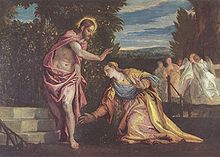 Noli me tangere, Museum of Grenoble, France
Noli me tangere, Museum of Grenoble, France
In addition to the ceiling creations and wall paintings, Veronese also produced altarpieces (The Consecration of Saint Nicholas, 1561–2, London's National Gallery [2]), paintings on mythological subjects (Venus and Mars, 1578, New York Metropolitan Museum of Art [3]), and portraits (Portrait of a Lady, 1555, Louvre). A significant number of compositional sketches in pen, ink and wash, figure studies in chalk, and chiaroscuro modelli and ricordi are in circulation. Veronese was one of the first painters whose drawings were sought by collectors during his lifetime.[17]
He headed a family workshop, including his brother Benedetto, sons Carlo and Gabriele, that remained active after his death in Venice in 1588. Among his pupils were his contemporary Giovanni Battista Zelotti and later Giovanni Antonio Fasolo and Luigi Benfatto (also called dal Friso; 1559–1611).[18]
Assessment
In 1648 Carlo Ridolfi wrote of the Feast in the House of Levi that it "gave rein to joy, made beauty majestic, made laughter itself more festive."[14]
A modern assessment of Veronese's achievement by Sir Lawrence Gowing is worth quoting at length:
The French had no doubts, as the critic Théophile Gautier wrote in 1860, that Veronese was the greatest colorist who ever lived—greater than Titian, Rubens, or Rembrandt because he established the harmony of natural tones in place of the modeling in dark and light that remained the method of academic chiaroscuro. Delacroix wrote that Veronese made light without violent contrasts, "which we are always told is impossible, and maintained the strength of hue in shadow.
This innovation could not be better described. Veronese's bright outdoor harmonies enlightened and inspired the whole nineteenth century. He was the foundation of modern painting. But whether his style is in fact naturalistic, as the Impressionists thought, or a more subtle and beautiful imaginative invention must remain a question for each age to answer for itself.[19]
Anthology of works
- St. Anthony Tempted by the Devil (1552–1553) – Oil on canvas, 198 × 151 cm, Musée des Beaux-Arts, Caen
- Zeus ousting the Vices (c. 1553) – Oil on canvas, 650 × 330 cm, Musée du Louvre, Paris
- St. Mark Crowning the Virtue (c. 1554) – Oil on canvas, 330 × 317 cm, Musée du Louvre, Paris
- Coronation of the Virgin (1555) – Oil on canvas, San Sebastiano, Venice
- Portrait of a Woman (c. 1555–1560) – Oil on canvas, 119 × 103 cm, Musée du Louvre, Paris
- Annunciation (c. 1555) – Oil on canvas, 193 × 291 cm, Uffizi, Florence
- Jesus among the Doctors in the Temple (1558) – Oil on canvas, 236 × 430 cm, Museo del Prado, Madrid
- Assumption of the Virgin (c. 1558) – Oil on canvas, 340 × 455 cm, San Giovanni e Paolo, Venice
- The Marriage at Cana (c. 1560) – Oil on canvas, 207 × 457 cm, Gemäldegalerie, Dresden
- Portrait of a Man (c. 1560) – Oil on canvas, 120 × 102 cm, Museum of Fine Arts, Budapest
- Bacchus Giving Wine to Men (1560–1561) – Fresco, Villa Barbaro, Maser
- Giustiniana Giustiniani with Her Nurse (1560–1561) – Fresco, Villa Barbaro, Maser
- Venus and Adonis (after 1561) – Oil on canvas, 123 × 174 cm, Staatliche Kunstsammlungen, Augsburg
- Virgin in Glory with Saints (c. 1562) – Oil on canvas, San Sebastiano, Venice
- St. John the Baptist Preaching (c. 1562) – Oil on canvas, Galleria Borghese, Rome
- Madonna Enthroned with Saints (c. 1562) – Oil on canvas, 339 × 191 cm, Gallerie dell'Accademia, Venice
- The Marriage at Cana (1563) – Oil on canvas, 666 × 990 cm, Musée du Louvre, Paris
- Petrobelli altarpiece
- Holy Family and Saints (San Zaccaria Altapiece; 1564) – Oil on canvas, 328 × 188 cm, Gallerie dell'Accademia, Venice
- Martyrdom of St. George (1564) –Oil on canvas, 426 × 305 cm, San Giorgio in Braida, Verona
- Sts. Mark and Marcellian Being Led to Martyrdom (1565) – Oil on canvas, San Sebastiano, Venice
- Martyrdom of St. Sebastian (1565) – Oil on canvas, San Sebastiano, Venice
- The Family of Darius before Alexander (1565–1570) – Oil on canvas, 236.2 × 475.9 cm, National Gallery, London
- Portrait of Daniele Barbaro (1565–1567) – Oil on canvas, 121 × 105.5 cm, Rijksmuseum, Amsterdam
- The Allegory of Love: Unfaithfulness (1570) – Oil on canvas, 191 × 191 cm, National Gallery, London
- The Finding of Moses (c. 1570–1575) – Oil on canvas, Kunsthistorisches Museum, Vienna
- Bathsheba at Bath (c. 1575) – Oil on canvas, 191 × 224 cm, Museum of Fine Arts of Lyon, Lyon
- Portrait of a Sculptor (c. 1550–1585) – Oil on canvas, 110.5 × 89 cm, Metropolitan Museum of Art, New York
- Battle of Lepanto (c. 1572) – Oil on canvas, 169 × 137 cm, Gallerie dell'Accademia, Venice
- Feast of St Gregory the Great (1572) – Oil on canvas, Monte Berico, Vicenza, Italy
- The Feast in the House of Levi (1573) – Oil on canvas, 555 × 1,280 cm, Gallerie dell'Accademia, Venice
- The Martyrdom of St. Justine (c. 1573) – Oil on canvas, 103 × 113 cm, Uffizi, Florence
- Ceres Renders Homage to Venice (1575) – Oil on canvas, 309 × 328 cm, Gallerie dell'Accademia, Venice
- Mystical Marriage of St Catherine (c. 1575) – Oil on canvas, 337 × 241 cm, Gallerie dell'Accademia, Venice
- The Allegory of Love: Unfaithfulness (c. 1575) – Oil on canvas, 187 × 188 cm, National Gallery, London
- Venus, Mars and Love with a Horse (c. 1575) – Oil on canvas, 47 × 47 cm, Galleria Sabauda, Turin
- Pietà (1576–1582) – Oil on canvas, 147 × 115 cm, The Hermitage, St. Petersburg
- The Resurrection of Christ (c. 1578) – Oil on canvas, 273 × 156 cm, The Chapel, Chelsea and Westminster Hospital, London
- Mars and Venus United by Love (c. 1578) – Oil on canvas, 205.7 × 161 cm, Metropolitan Museum of Art, New York
- Hermes, Herse and Aglaulus (1576–1584) – Oil on canvas, 232.4 × 173 cm, Fitzwillian Museum, Cambridge
- The Rape of Europa (1580) – Oil on canvas, 240 × 303 cm, Sala dell'Anticollegio, Doge's Palace, Venice
- Venus and Adonis (1580) – Oil on canvas, 212 × 191 cm, Museo del Prado, Madrid
- Christ and the Centurion (c. 1580) – Oil on canvas, 99.2 × 130.8 cm, Toledo Museum of Art, Toledo Museum of Art, Toledo, OH
- Lucretia (1580s) – Oil on canvas, 109 × 90.5 cm, Kunsthistorisches Museum, Vienna
- Christ in the Garden Supported by an Angel (c. 1580) – Oil on canvas, 80 × 108 cm, Pinacoteca di Brera, Milan
- St. Anthony Preaching to the Fish (c. 1580) – Oil on canvas, Galleria Borghese, Rome
- The Vision of St. Helena (c. 1580) – Oil on canvas, 166 × 134 cm, Pinacoteca Vaticana
- Allegory of Wisdom and Strength (c. 1580) – Oil on canvas, 214.6 × 167 cm, Frick Collection, New York
- Judith and Holofernes (c. 1580) – Oil on canvas, 195 × 176 cm, Galleria di Palazzo Rosso, Genoa
- The People of Myra Welcoming St. Nicholas (c. 1582) – Oil on canvas, diameter: 198 cm, Gallerie dell'Accademia, Venice
- Apotheosis of Venice (1585) – Oil on canvas, 904 × 579 cm, Doge's Palace, Venice
- The Conversion of Saint Pantaleimon (1587) – San Pantalon, Venice
- Portrait of Agostino Barbarigo – Oil on canvas, 60 × 48 cm, Museum of Fine Arts, Budapest
- Baptism and Temptation of Christ – Oil on canvas, 245 × 450 cm, Pinacoteca di Brera, Milan
- Portrait of a Venetian Woman (La Bella Nani) – Oil on canvas, 117.3 × 100.8 cm, Alte Pinakothek, Munich
- Susanna in the Bath – Oil on canvas, 198 × 198 cm, Musée du Louvre, Paris
- Noli me tangere – Oil on canvas, Museum of Grenoble, France
- Sitting dog – Oil on canvas, 44 × 82 cm, National Gallery, Oslo
Veronese in popular culture
- The Monty Python sketch "The Last Supper" from Monty Python Live at the Hollywood Bowl is based on the story of Veronese's painting The Feast in the House of Levi.
- An imaginary Veronese painting called "La Morte dil Cesare" is prominently featured in a story arc of the award winning comics series 100 Bullets.
Veronese in religion
- In theosophy and in the Ascended Master Teachings, a group of religions based on theosophy, Paolo Veronese is worshipped as one of the ascended masters, a group of deities governing the planet Earth. Specifically, he is regarded as the Master Paul the Venetian, Master of the Third Ray.
Notes
- ^ Rearick, W. R.: The Art of Paolo Veronese 1528–1588, page 20. National Gallery of Art, 1988. His earliest known painting is signed "P. Caliari F.," the first known instance in which he used this surname, which he seems to have adopted, since his parents appear not to have had one.
- ^ Rearick, page 20, 1988.
- ^ Bussagli, Marco: "The XVI Century", Italian Art, page 206. Giunti Gruppo Editoriale, 2000.
- ^ Dunkerton, Jill, et al.: Durer to Veronese: Sixteenth-Century Painting in the National Gallery, page 125. National Gallery Publications, 1999.
- ^ Rearick, page 50, 1998.
- ^ Rearick, page 75, 1988.
- ^ The Portrait of Daniele Barbaro, painted 1566–67, entered the collection of the Rijksmuseum in Amsterdam in 1952. Veronese: Gods, Heroes and Allegories, De Vecchi, Pierluigi, pages 104–5. Rizzoli, 2004.
- ^ a b Rearick, page 10, 1998.
- ^ Bussagli, page 207, 2000.
- ^ Louvre 1993
- ^ Dunkerton, et al., page 111, 1999.
- ^ a b Rearick, page 13, 1988.
- ^ Dunkerton, et al., page 30, 1999.
- ^ a b Rearick, page 14, 1988.
- ^ Rearick, page 104, 1988.
- ^ Rearick, page 104, 1988. Transcript of the hearing
- ^ Eisler, Colin: Masterworks in Berlin: A City's Paintings Reunited, page 270. Little, Brown and Company, 1996.
- ^ *Bernasconi, Cesare (1864). Painting Studi sopra la storia della pittura italiana dei secoli xiv e xv e della scuola pittorica veronese dai medi tempi fino tutto il secolo xviii. Googlebooks. pp. 337–338, 343.
- ^ Gowing, Lawrence: Paintings in the Louvre, page 262. Stewart, Tabori & Chang, 1987.
References
- Freedberg, Sydney J. (1993). Pelican History of Art. ed. Painting in Italy, 1500–1600. Penguin Books Ltd. pp. 550–60.
- Irollo, Jean-Marc, Veronese et le miracle des Noces, Louvre, chercheurs d'art, RMN, 1993
External links
- Art view; Homage to a Gentleman of Verona [4]
- Veronese biography on Web Gallery of Art with link to images of many of his paintings
- Paolo Caliari – Biographical article in the 1911 Catholic Encyclopedia
- Gallery at Museum Syndicate
- Veronese at Panopticon Virtual Art Gallery
Categories:- 1528 births
- 1588 deaths
- 16th-century Italian people
- Italian painters
- Mannerist painters
- Renaissance painters
- Venetian painters
Wikimedia Foundation. 2010.

